RARE! WWII Japanese OPERATION TEN-GO April 1945 Okinawa USS Vincennes USN Report
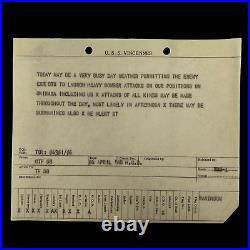
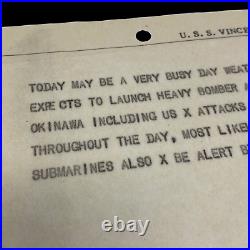
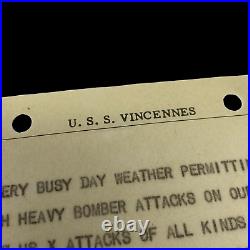
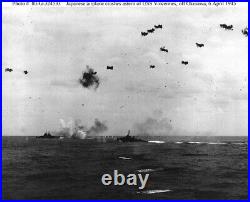
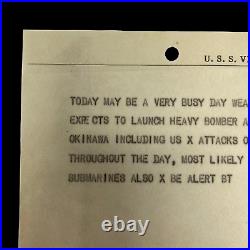
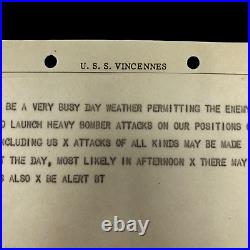
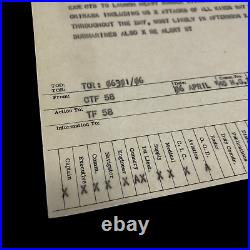
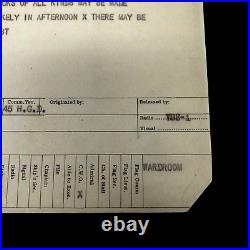
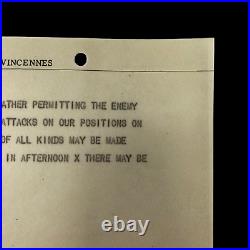
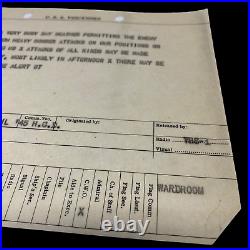
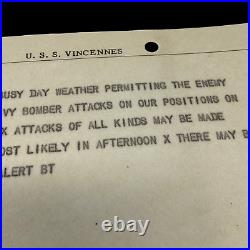
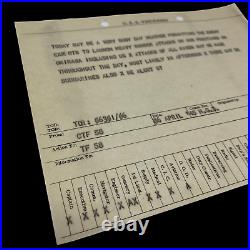

And a full historical write-up. Japanese air opposition had been relatively light during the first few days after the landings. However, on April 6th, 1945, the expected air reaction began with an attack by 400 Japanese kamikaze planes from Kyushu.
Periodic heavy air attacks continued through April. For their part, by 30 April, the Japanese had lost more than 1,100 planes to Allied naval forces alone. This incredibly rare and museum-grade original U. Navy Task Force 58 intelligence message was printed and sent directly to the USS.
(CL-64) on April 6th, 1945. Just 5 days after the D-Day landings on Okinawa also known as Operation Iceberg.What makes this Task Force 58 USS. (CL-64) intelligence report extremely rare is that this intelligence report is the first report sent to U. This report was correct intelligence of what would be famously known as "OPERATION TEN-GO".
This report on Task Force 58 report on April 6th, 1945 warns of. This a one-of-one museum-grade WWII artifact and is the only OPERATION TEN-GO warning report known to exist of Japanese Kamake Floating Chrysanthemums Attack No. The United States Navy's Task Force 58, deployed to the east of Okinawa with a picket group of 6 to 8 destroyers, kept 13 carriers (7 CVs and 6 CVLs) on duty from 23 March to 27 April and a smaller number thereafter. Until 27 April, a minimum of 14 and up to 18 escort carriers (CVEs) were in the area at all times. Until 20 April, British Task Force 57, with 4 large and 6 escort carriers, remained off the Sakishima Islands to protect the southern flank. The protracted length of the campaign under stressful conditions forced Admiral Chester W. Nimitz to take the unprecedented step of relieving the principal naval commanders to rest and recuperate. Following the practice of changing the fleet designation with the change of commanders, US naval forces began the campaign as the US 5th Fleet under Admiral Raymond Spruance but ended it as the 3rd Fleet under Admiral William Halsey.However, on 6 April, the expected air reaction began with an attack by 400 planes from Kyushu. Between 6 April and 22 June, the Japanese flew 1,465.
Aircraft in large-scale attacks from Kyushu, 185 individual. Sorties from Kyushu, and 250 individual. While US intelligence estimated there were 89 planes on Formosa, the Japanese actually had about 700, dismantled or well camouflaged and dispersed into scattered villages and towns; the US Fifth Air Force disputed Navy claims of. While no major allied warships were lost, several fleet carriers were severely damaged.
Land-based Shin'yo-class suicide motorboats were also used in the Japanese suicide attacks, although Ushijima had disbanded the majority of the suicide boat battalions before the battle due to expected low effectiveness against a superior enemy. The boat crews were re-formed into three additional infantry battalions. Was the attempted attack by a strike force of 10 Japanese surface vessels, led by. And commanded by Admiral Seiichi Ito. This small task force had been ordered to fight through enemy naval forces, then beach.
And fight from shore, using her guns as coastal artillery and her crew as naval infantry. Force was spotted by submarines shortly after it left the Japanese home waters, and was intercepted by US carrier aircraft. Under attack from more than 300 aircraft over a two-hour span, the world's largest battleship sank on 7 April 1945, after a one-sided battle, long before she could reach Okinawa. US torpedo bombers were instructed to aim for only one side to prevent effective counter-flooding by the battleship's crew, and to aim for the bow or the stern, where armor was believed to be the thinnest. S screening force, the light cruiser.
And 4 of the 8 destroyers were also sunk. The Imperial Japanese Navy lost some 3,700 sailors, including Admiral Ito, at the cost of 10 US aircraft and 12 airmen. By 6 April 1945, in reaction to the U. Landings on Okinawa, the Japanese had amassed about 700 aircraft in Formosa and the southern Japanese island of Kyushu to attack the U.
The Japanese launched their first and largest mass. 1, during which 230 Japanese navy and 125 Japanese army (355 total). Another 340 or so planes conducted conventional attacks. Some attacks occurred in large formations and others occurred in small numbers or even by single aircraft at almost all hours, so the threat was near constant. Dawn and especially dusk were the worst times, as the Japanese tried to time the bigger raids for when U.
Combat air patrols were returning to their carriers before nightfall. Vincennes Combat History During WWII. Class light cruiser built at Quincy, Massachusetts, was commissioned in January 1944. The new cruiser was soon in action, taking part in the Marianas Campaign in June, July and August 1944 as part of Task Force 58. During this time she screened aircraft carriers during the Battle of the Philippine Sea and strikes on the Mariana, Bonin and Volcano Islands.
Continued to operate with the fast carriers during the Palaus Campaign in September, strikes in the Western Pacific in October, the Battle of Leyte Gulf on 24-25 October, and operations connected with the Philippines Campaign from November 1944 into January 1945. She also bombarded the enemy ashore in the Palaus, helped sink a Japanese warship during the final part of the Leyte Gulf battle, covered the withdrawal of the crippled cruisers. (CA-70) after they were torpedoed off Formosa in mid-October, and successfully rode out a bad typhoon in December. During February and March 1945.
Participated in attacks on the Japanese home islands and supported the Iwo Jima Campaign, mainly as an escort for the carrier fleet, but also using her guns to shell Okino Daito Shima. Fired nearly 6000 six-inch projectiles and over 10,500 rounds from her five-inch guns at enemy artillery, troops and supply dumps.
